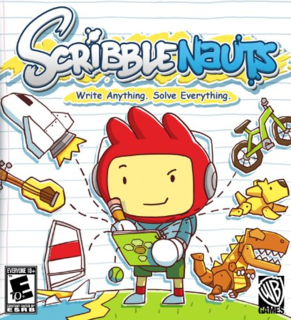Solve every puzzle your way, and then some!
Let's get that flaw out of the way right now: Controls. It's pretty much touch-screen only. You move Maxwell (main character), manipulate objects, and type/write objects on the touch screen, while camera control is handled by the D-pad or face buttons pending you're left or right handed. While not a horrible setup, the sensitivity of the touching can off or far to high. If you're not careful, you'll be trying to grab an object and not hold the stylus on the screen long enough or just not too close and cause Maxwell to dash to the position you just touched, usually making your job harder or worst case, cause you to fail the puzzle. Other notable frustrations can be the camera and the physics. The camera can look throughout the entire stage regardless Maxwell's position and automiatically snaps back to Maxwell if it's not manipulated within a certain amount of time. While this can be helpful if you lose track of the kid or you're ready to intiate your solution, when you are just contemplating the environment it can get annoying to have to nudge the camera to keep your focus. It would have been better to have the snap-back command mapped to a shoulder button instead of automating it. The Physics are just wonky. However, the wonkiness works for you just as often as it works against you.
Despite those inconveniences, this game is filled with fun and will be talked about for decades to come. You have a solid art style that can appeal to all ages. Every character and objects is drawn in a simple style making everything look like a paper figure. The objects animate as such making it seem like a children's book come to life and you have control over it. Just about anything you can think of, along with many things you haven't, are in the game for you to write and use. All the objects work like they do in real life for the most part. Some objects can't be rotated or function like would as 3D objects, but something else will fill in for that lack. The music of the game is largely forgettable and you can unlock more tracks for a variety. You'll find some tracks more catchy than others, but it's nothing that can make or break the experience.
The main course of the game is the 11 worlds of puzzles, one being a tutorial world and each have a set of "puzzle-type" and "action-type" stages. The main difference is the Action-type stages usually have enemies that will attack you. Your goal is always to collect the starite placed in the stage, finding a way around the various obstacles between you and it. Over 200 puzzles are there with over dozens of ways for them to be solved. Once a puzzle is solved, you earn "ollars" (game currency) which you use to purchase new worlds and other unlockables. You earn extra ollars by solving puzzles fast, using new items you've haven't used before, using specific items, and using fewer items than the Par for the stage indicates. After the first time clearing a stage, you can go through it again where you have to clear it 3 more times in a row, not repeating the items you summoned previously.
Once you've cleared the preset stages, you can go into the stage editor and create your own challenges using the preset stages as empty templates. You can't change the geography, but you can place the normal objects into it and place the starite wherever you please. You can also manipulate the relationships of objects, adjusting whether a creature will guard another items, be attracted to a specific item, or attack/guard something. Then you can share these stages with friends to keep the challenges coming forever.
The lasting appeal to this game is seeing just how many things there are in this game. You'll be surprised how items work in the game and will cause you problem solve in new, unique ways. Your going to have crazy stories to share about the wacky methods you used to solve a puzzle or the discovery of what happens when you pit two objects against each other (God and Witch for one). If you own a DS, there is no reason to not buy this game.

